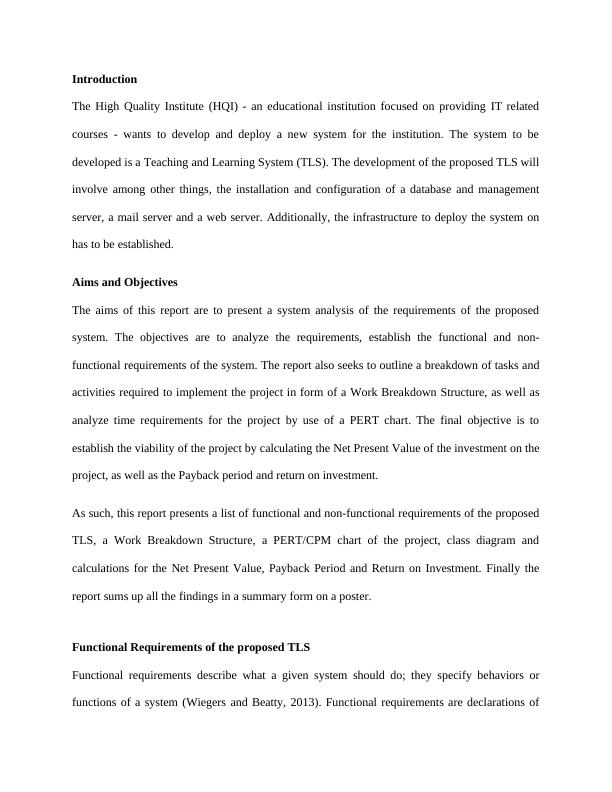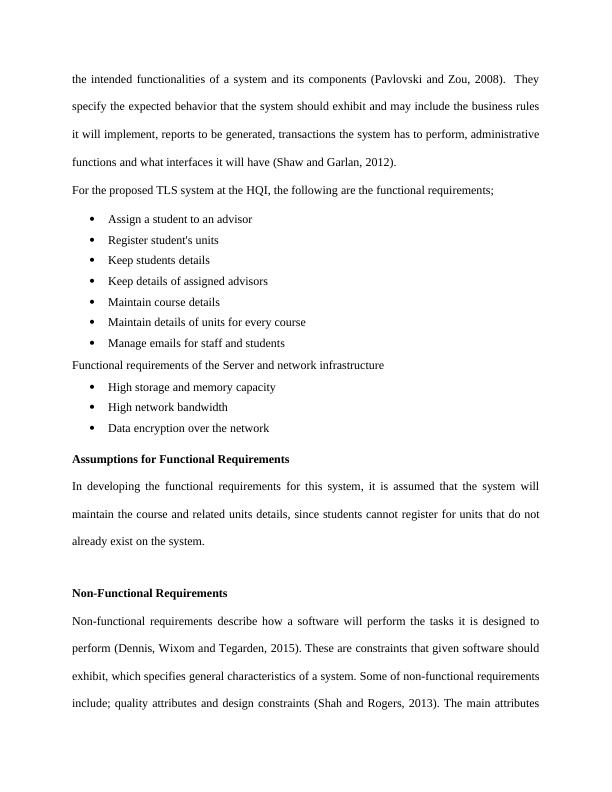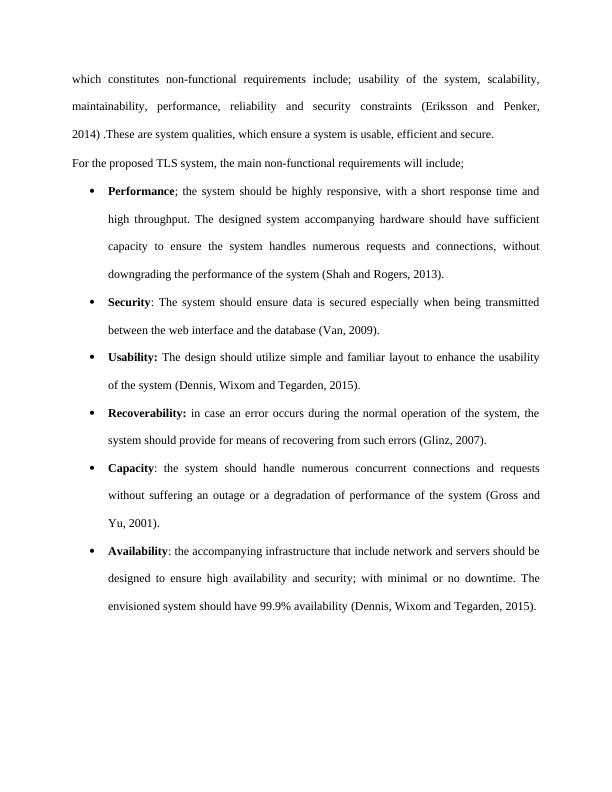Ask a question from expert
SMB4201 Systems Analysis and Design : Assignment
13 Pages2122 Words81 Views
Added on 2020-05-11
SMB4201 Systems Analysis and Design : Assignment
Added on 2020-05-11
BookmarkShareRelated Documents
SMB4201 Systems Analysis and Design Student numberNameLecturerTutor Assignment 3

IntroductionThe High Quality Institute (HQI) - an educational institution focused on providing IT relatedcourses - wants to develop and deploy a new system for the institution. The system to bedeveloped is a Teaching and Learning System (TLS). The development of the proposed TLS willinvolve among other things, the installation and configuration of a database and managementserver, a mail server and a web server. Additionally, the infrastructure to deploy the system onhas to be established. Aims and ObjectivesThe aims of this report are to present a system analysis of the requirements of the proposedsystem. The objectives are to analyze the requirements, establish the functional and non-functional requirements of the system. The report also seeks to outline a breakdown of tasks andactivities required to implement the project in form of a Work Breakdown Structure, as well asanalyze time requirements for the project by use of a PERT chart. The final objective is toestablish the viability of the project by calculating the Net Present Value of the investment on theproject, as well as the Payback period and return on investment. As such, this report presents a list of functional and non-functional requirements of the proposedTLS, a Work Breakdown Structure, a PERT/CPM chart of the project, class diagram andcalculations for the Net Present Value, Payback Period and Return on Investment. Finally thereport sums up all the findings in a summary form on a poster. Functional Requirements of the proposed TLSFunctional requirements describe what a given system should do; they specify behaviors orfunctions of a system (Wiegers and Beatty, 2013). Functional requirements are declarations of

the intended functionalities of a system and its components (Pavlovski and Zou, 2008). Theyspecify the expected behavior that the system should exhibit and may include the business rulesit will implement, reports to be generated, transactions the system has to perform, administrativefunctions and what interfaces it will have (Shaw and Garlan, 2012).For the proposed TLS system at the HQI, the following are the functional requirements;Assign a student to an advisorRegister student's unitsKeep students detailsKeep details of assigned advisorsMaintain course detailsMaintain details of units for every courseManage emails for staff and studentsFunctional requirements of the Server and network infrastructureHigh storage and memory capacityHigh network bandwidthData encryption over the networkAssumptions for Functional RequirementsIn developing the functional requirements for this system, it is assumed that the system willmaintain the course and related units details, since students cannot register for units that do notalready exist on the system. Non-Functional RequirementsNon-functional requirements describe how a software will perform the tasks it is designed toperform (Dennis, Wixom and Tegarden, 2015). These are constraints that given software shouldexhibit, which specifies general characteristics of a system. Some of non-functional requirementsinclude; quality attributes and design constraints (Shah and Rogers, 2013). The main attributes

which constitutes non-functional requirements include; usability of the system, scalability,maintainability, performance, reliability and security constraints (Eriksson and Penker,2014) .These are system qualities, which ensure a system is usable, efficient and secure.For the proposed TLS system, the main non-functional requirements will include;Performance; the system should be highly responsive, with a short response time andhigh throughput. The designed system accompanying hardware should have sufficientcapacity to ensure the system handles numerous requests and connections, withoutdowngrading the performance of the system(Shah and Rogers, 2013).Security: The system should ensure data is secured especially when being transmittedbetween the web interface and the database (Van, 2009).Usability: The design should utilize simple and familiar layout to enhance the usabilityof the system (Dennis, Wixom and Tegarden, 2015).Recoverability: in case an error occurs during the normal operation of the system, thesystem should provide for means of recovering from such errors (Glinz, 2007). Capacity: the system should handle numerous concurrent connections and requestswithout suffering an outage or a degradation of performance of the system(Gross andYu, 2001). Availability: the accompanying infrastructure that include network and servers should bedesigned to ensure high availability and security; with minimal or no downtime. Theenvisioned system should have 99.9% availability (Dennis, Wixom and Tegarden, 2015).

End of preview
Want to access all the pages? Upload your documents or become a member.
Related Documents
High Quality Institute (HQI) Case Study Reportlg...
|10
|1690
|57
High Quality Institute (HQI) Case Studylg...
|10
|1743
|32
System Analysis and Designlg...
|15
|2870
|33
Teaching and Learning System (TLS) Analysis Reportlg...
|16
|1941
|114
SYSTEM ANALYSIS AND DESIGN 1 SYSTEM ANALYSIS AND DESIGN 1lg...
|16
|2247
|270
Design and Analysis of a Teaching and Learning System at High Quality Institutelg...
|16
|3148
|393